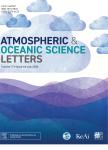A New Method for Predicting the Decadal Component of Global SST
A New Method for Predicting the Decadal Component of Global SST作者机构:Nansen-Zhu International Research Centre and Climate Change Research Center Institute of Atmospheric Physics Chinese Academy of Sciences Beijing 100029 China Graduate University of Chinese Academy of Sciences Beijing 100049 China Nansen Environmental and Remote Sensing Center/Bjerknes Center for Climate Research Bergen Norway Geophysical Institute and Bjerknes Center for Climate Research University of Bergen Bergen Norway
出 版 物:《Atmospheric and Oceanic Science Letters》 (大气和海洋科学快报(英文版))
年 卷 期:2012年第5卷第6期
页 面:521-526页
学科分类:0710[理学-生物学] 07[理学] 0908[农学-水产] 070601[理学-气象学] 0707[理学-海洋科学] 0706[理学-大气科学] 0816[工学-测绘科学与技术] 0825[工学-航空宇航科学与技术]
基 金:supported by the Strategic Priority Research Program of the Chinese Academy of Sciences(Grant Nos.XDA05090406 and XDA05110203) the special projects of the China Meteorological Administration(Grant No.GYHY201006022) contribution to the DecCen and Blue Arc projects funded by the Research Council of Norway and to the Centre for Climate Dynamics at the Bjerknes Centre
主 题:年代际变化 SST 预测 分量 太平洋年代际振荡 海洋表面温度 表层海水温度 耦合模式
摘 要:A simple approach that considers both internal decadal variability and the effect of anthropogenic forcing is developed to predict the decadal components of global sea surface temperatures (SSTs) for the three decades 2011-2040. The internal decadal component is derived by harmonic wave expansion analyses based on the quasiperiodic evolution of the Pacific Decadal Oscillation (PDO) and the Atlantic Multidecadal Oscillation (AMO), as obtained from observational SST datasets. Furthermore, the external decadal component induced by anthropogenic forcing is assessed with a second-order fit based on the ensemble of projected SSTs in the experiments with multiple coupled climate models associated with the third Coupled Model Intercomparison Project (CMIP3) under the Intergovernmental Panels on Climate Change (IPCC) Special Reports on Emissions Scenario (SRES) A1B. A validation for the years from 2002 to 2010 based on a comparison of the predicted and the observed SST and their spatial correlation, as well as the root mean square error (RMSE), suggests that the approach is reasonable overall. In addition, the predicted results over the 50°S-50°N global band, the Indian Ocean, the western Pacific Ocean, the tropical eastern Pacific Ocean, and the North and the South Atlantic Ocean are presented.



